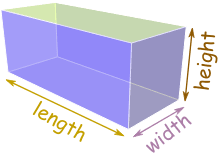eddy2017
Elite Member
- Joined
- Oct 27, 2017
- Messages
- 2,525
A teacher covered the exterior of a rectangular prism-shaped box that measured 8 inches by 9 inches by 10 inches using one sheet of rectangular-shaped wrapping paper that measured 2 feet by 3 feet. There were no gaps or overlapping paper. How many square inches of wrapping paper were left over?
Choose an answer

I know this is about finding the are of a rectangular prism. the formula is
A = 2wl + 2lh + 2hw, where w is the width, the l is the length, and the h is the height.
I have:
[math]width =8 inches[/math][math]length= 9 inches[/math][math]height=10in[/math] First, I will find the area of the rectangular prism box
[math][B]A = 2(wl) + 2(lh) + 2(hw)[/math][math]A=2(8*9) + 2(9*10) + 2(10*8)[/math][math]A =[/math]2(72) +2(90) + 2(80) in^3[math][/math] A=114+180+160[math][/math]A=484 in^3$$
the area of the rectangular-prism box is 484 cubic inches.
any hint now?
thanks,
eddy[/B]
Choose an answer
- 144
- 380
- 484
- 622

I know this is about finding the are of a rectangular prism. the formula is
A = 2wl + 2lh + 2hw, where w is the width, the l is the length, and the h is the height.
I have:
[math]width =8 inches[/math][math]length= 9 inches[/math][math]height=10in[/math] First, I will find the area of the rectangular prism box
[math][B]A = 2(wl) + 2(lh) + 2(hw)[/math][math]A=2(8*9) + 2(9*10) + 2(10*8)[/math][math]A =[/math]2(72) +2(90) + 2(80) in^3[math][/math] A=114+180+160[math][/math]A=484 in^3$$
the area of the rectangular-prism box is 484 cubic inches.
any hint now?
thanks,
eddy[/B]
Last edited:
